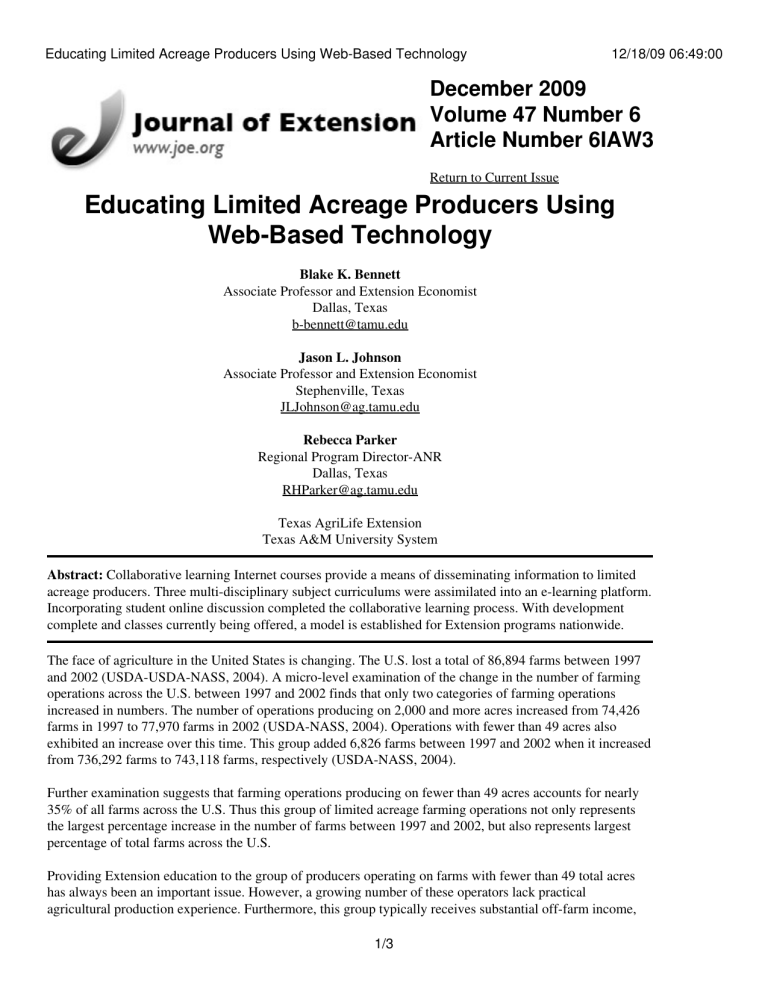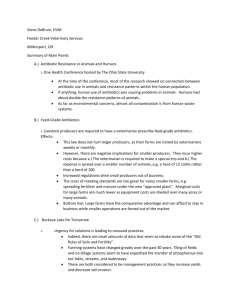Educating Limited Acreage Producers Using Web-Based Technology December 2009 Volume 47 Number 6

Educating Limited Acreage Producers Using Web-Based Technology 12/18/09 06:49:00
December 2009
Volume 47 Number 6
Article Number 6IAW3
Return to Current Issue
Educating Limited Acreage Producers Using
Web-Based Technology
Blake K. Bennett
Associate Professor and Extension Economist
Dallas, Texas b-bennett@tamu.edu
Jason L. Johnson
Associate Professor and Extension Economist
Stephenville, Texas
JLJohnson@ag.tamu.edu
Rebecca Parker
Regional Program Director-ANR
Dallas, Texas
RHParker@ag.tamu.edu
Texas AgriLife Extension
Texas A&M University System
Abstract: Collaborative learning Internet courses provide a means of disseminating information to limited acreage producers. Three multi-disciplinary subject curriculums were assimilated into an e-learning platform.
Incorporating student online discussion completed the collaborative learning process. With development complete and classes currently being offered, a model is established for Extension programs nationwide.
The face of agriculture in the United States is changing. The U.S. lost a total of 86,894 farms between 1997 and 2002 (USDA-USDA-NASS, 2004). A micro-level examination of the change in the number of farming operations across the U.S. between 1997 and 2002 finds that only two categories of farming operations increased in numbers. The number of operations producing on 2,000 and more acres increased from 74,426 farms in 1997 to 77,970 farms in 2002 (USDA-NASS, 2004). Operations with fewer than 49 acres also exhibited an increase over this time. This group added 6,826 farms between 1997 and 2002 when it increased from 736,292 farms to 743,118 farms, respectively (USDA-NASS, 2004).
Further examination suggests that farming operations producing on fewer than 49 acres accounts for nearly
35% of all farms across the U.S. Thus this group of limited acreage farming operations not only represents the largest percentage increase in the number of farms between 1997 and 2002, but also represents largest percentage of total farms across the U.S.
Providing Extension education to the group of producers operating on farms with fewer than 49 total acres has always been an important issue. However, a growing number of these operators lack practical agricultural production experience. Furthermore, this group typically receives substantial off-farm income,
1/3
Educating Limited Acreage Producers Using Web-Based Technology 12/18/09 06:49:00 suggesting the time to obtain traditional Extension education is limited (USDA-ERS, 2007). Thus, the problem becomes one of how to disseminate agricultural production and profitability information to the largest group of agricultural producers in a way that fits into their schedule as well as their education level.
Collaborative learning, learners exchanging information and personal experience to obtain knowledge of a subject under the direction of a facilitator, has been effectively used in the classroom setting. This type of learning allows for less knowledgeable members to learn from the explanations of more advanced peers.
Simultaneously, the more knowledgeable peers benefit from providing these explanations (Dillenbourg &
Schneider, 1994). Given the obstacles discussed above facing limited acreage producers, our objective was to create a set of collaborative learning classes enabling information dissemination while adhering to time limitations.
Data and Methods
Adapting a collaborative learning style to agricultural operators who have off-farm employment required the use of an instrument that would provide learners information in a way that met their time requirements. The advent of Internet classrooms provided such an instrument and was used. The online platform used to assimilate all developed materials was Moodle. This free software e-learning platform is designed to help educators create online courses with opportunities for learner interaction.
After choosing an online platform to use, multi-disciplinary Extension programs most requested by limited acreage producers were identified. This was accomplished through discussions with county Extension agents as well as Extension specialists. These discussions took place over a 6-month period both in person as well as via telephone conferencing.
A set of curriculum to be used in each of the online Extension courses was then developed by Extension specialists. The curriculum was adapted from existing material pertaining to each subject and was expressed in such a way that novice as well as experienced agricultural producers could grasp the concepts. The specialists also identified additional resources that would assist in learning and applying the information being covered in each class. All information was then assimilated into the e-learning platform.
The final phase of developing each Extension online course was to create a discussion area for learners to exchange information and ideas pertaining to the specific module being covered. The exchange of ideas is directed by county Extension agents who volunteered and were trained to facilitate each of the courses.
Major Results and Implications
The three multi-disciplinary Extension courses adapted to an online collaborative learning format were: the development of a resource inventory, an introduction to beef cattle management, and an introduction to pasture establishment and maintenance. Curriculum used in each of these courses includes a short generic publication explaining the concept of the class and providing the initial background information to the learner. A case study farming operation along with worksheets are also provided, allowing learners to not only see an application of the information but also assist in applying it to their own operation. A narrated slide presentation summarizing the publication, case study application and worksheets is the final set of curriculum developed for each of the courses. All curriculums are assimilated into the Moodle learning environment for the three separate courses.
Volunteer county Extension agents having a large concentration of limited acreage producers as their clientele were chosen to facilitate each of the courses. Course facilitation does differ from course instruction.
2/3
Educating Limited Acreage Producers Using Web-Based Technology 12/18/09 06:49:00
In a collaborative learning environment, the class reads the required material and then responds to discussion questions posed by the facilitator. Learning is accomplished through online discussion of the questions among class members. The facilitator's role is to guide discussion and answer specific questions but not to lecture.
Providing information to agricultural producers operating on limited acreage is greatly needed but has been met with the constraints of time limitations of both Extension educators as well as clientele. As described, an online classroom setting provides the flexibility needed to accomplish the goals of providing the information while also adhering to the time constraints of both groups. Incorporating the collaborative learning environment via the Internet is also unique to Extension programming. With development complete and classes currently being offered, this set of courses can serve as a model for Extension programs nationwide.
References
Dillenbourg, P., & Schneider, D. (1994). Collaborative learning in the Internet. Proceedings of the Fourth
International Conference on Computer Assisted Instruction, Taiwan, S10-6 to S10-13.
United States Department of Agriculture-Economic Research Service. (2007). Structure and finances of U.S.
farms. Family Farm Report, 2007 Edition. Washington, DC. Economic Information Bulletin No. 24.
United States Department of Agriculture-National Agricultural Statistics Service. (2004). Census of
agriculture, 2002. Washington, DC: U.S. Government Printing Office.
Copyright © by Extension Journal, Inc. ISSN 1077-5315. Articles appearing in the Journal become the property of the Journal. Single copies of articles may be reproduced in electronic or print form for use in educational or training activities. Inclusion of articles in other publications, electronic sources, or systematic large-scale distribution may be done only with prior electronic or written permission of the Journal Editorial
Office, joe-ed@joe.org.
If you have difficulties viewing or printing this page, please contact JOE Technical Support.
3/3




